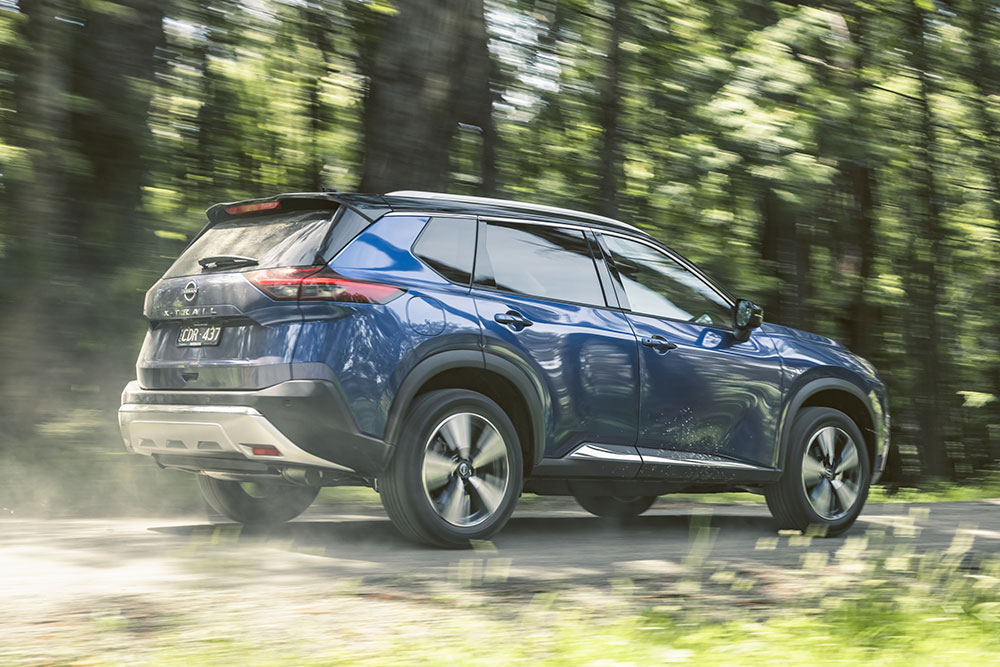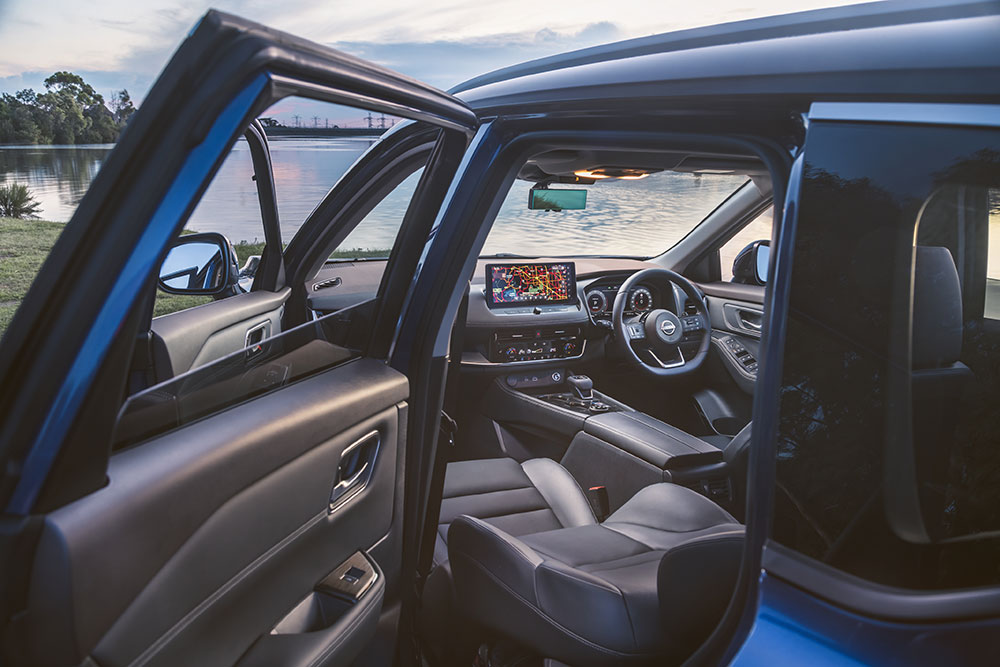Nissan X-Trail review

Product planning, including the cadence of when to release new and updated models, is a crucial part of every car maker’s strategy.
It’s essential in remaining competitive with rivals, keeping existing owners wedded to your brand, and for attracting new customers with something bright, shiny and new.
Usually, car makers stretch out their new product launches in order to give each new model its time to shine before a rival inevitably comes along and steals the limelight.
However, for reasons not entirely apparent, other than the ubiquitous ‘Covid-related supply chain disruptions’, Nissan Australia has dropped four brand new products in the space of a few months, after an extended period of having precious little in the way of new products to spruik.
The X-Trail medium SUV tested here is one of three new Nissan SUVs and four new product launches in total that arrived at the back end of 2022, including the new Z sports car, the seven-seat Pathfinder, and the Qashqai medium SUV.
The X-Trail nameplate is well known here, having first launched in 2001, with this iteration being the fourth generation.
It’s typically been Nissan’s second highest-selling nameplate after the Navara ute, so Nissan and its dealers will no doubt be happy to have some fresh firepower in their SUV arsenal.
Redesigned from the ground up and based on a new Alliance CMF-C platform, the new X-Trail comes in six variants, comprising two 2WD models and four 4WD models, with two of the 4WD models equipped with seven seats.
Pricing starts at starts at $36,750 for the ST 2WD and top out with the fully loaded Ti-L 4WD, costing $52,990. Unusually for this class, there are also two seven-seat variants, the ST 4WD and ST-L 4WD cost $39,790 and $46,290 respectively.
Despite the new platform, the X-Trail sits on an identical wheelbase to its predecessor, with its overall length trimmed slightly, but boasting 20mm more width and a 15mm increase in height.
Modest though they are, these changes are claimed to free up more interior space with the new model accommodating taller and leggier passengers, while also offering easier rear access and egress thanks to wider-opening rear doors.

The new exterior styling is modern and muscular with styling elements include a ‘floating’ black-painted roof on certain models, Nissan’s corporate V-motion grille, and headlights set into the front bumper bodywork.
The side view reveals muscular wheel arches front and rear, with a fin-shaped C-pillar leading to wrap-around lights at the rear.
SUVs and aerodynamic were once an oxymoron but that’s no longer the case as car makers strive to lower the fuel consumption and emissions of these inherently chunky beasts.
In the case of the X-Trail that means ‘3D’ tyre deflectors in the lower front fascia, an active grille shutter to control air flow into the engine compartment, special A-pillar shaping, underbody covers to manage air flow beneath the vehicle, and an ‘air curtain’ that directs air flow from the front to the sides.
Despite this, fuel consumption from the only powertrain available, a 2.5-litre four-cylinder petrol boasting outputs of 135kW/244Nm and hitched to a CVT transmission, is a reasonable, but not stellar 7.4 to 7.8L/100km depending on variant.
The engine outputs are up 9kW and 18Nm over the previous model and the combination delivers smooth, confident acceleration, with the ability to manually override the shift-by-wire CVT transmission using paddle-shifts on the steering wheel.
Patient punters with an eye to lowering fuel consumption and emissions further, and with the budget to add $4,200 to the price of the Ti and Ti-L variants reviewed here, can look forward to new X-Trail e-Power hybrid versions arriving in early 2023.
These models feature a 1.5-litre variable compression turbocharged three-cylinder petrol engine that works as a generator for the car’s lithium-ion battery, which then provides power to an electric motor via an inverter.
Because the car’s electric motor exclusively drives the wheels, Nissan claims its e-Power models drive just like an electric vehicle.
They do still need to be refuelled with petrol, though, albeit less regularly than their conventionally powered counterparts, with combined cycle fuel consumption of 6.1L/100km.
Meanwhile, the regular X-Trail’s towing capability has been hiked by 500kg over the previous generation, to a handy 2,000kg braked, with trailer sway control fitted as standard.

That’s no doubt due in part to the fact the new model is claimed to be more structurally rigid, thanks to greater use of ultra-high-strength steel as well as advanced stamping and welding techniques to increase torsional strength.
The stiffer body also contributes to improved refinement, ride comfort and driving response, as well as better safety outcomes, according to Nissan.
Efforts have gone into reducing vehicle weight, with notable weight saving measures including the rear tailgate door being made of a composite material, and the front and rear doors, mudguards and hood all being made of aluminium.
Despite this, the new model’s extra kit cancels out any saving so it’s slightly heavier than its predecessor.
Suspension is via an updated Macpherson strut front and multi-link rear set-up, with the combination striking a mostly pleasing balance between ride comfort and dynamic response.
That said, the ride sometimes seemed a little terse on secondary roads and there’s no avoiding the inevitable issue of occupant head toss over bumps that comes with the territory of a high SUV riding body.
As is often the case, the base model ST riding on 17-inch alloy wheels and with higher-profile tyres offers a more compliant ride than its bigger-wheeled, lower-profile stablemates, where wheel sizes increase to 18-inch on the ST-L and 19s on the Ti and Ti-L.
The interior is comfortable and attractive, with a revised cabin layout and more premium features and materials, effectively lifting the perception of quality inside the cabin.
There are screens, of course, with sizes varying according to the spec level. The ST gets the most basic 7.0-inch TFT digital instrument cluster and 8.0-inch central display with DAB+ digital radio and six speakers.
Stepping up to the high-grade X-Trail models brings twin digital screens, including a 12.3-inch TFT instrument cluster, a 12.3-inch touchscreen display and a 10.8-inch Head-Up Display.
Fortunately, or not, depending on where you stand on such matters, Nissan hasn’t completely embraced the digital world, with the X-Trail retaining simple and intuitive heating/air-conditioning controls, plus buttons for central screen functions, such as audio and navigation.

The centre elbow rest features a ‘butterfly’ opening top which provides access to a large storage space beneath, while atop the floating centre console is a twist-dial drive mode selector. The latter provides access to five driving modes – Off-Road, Snow, Auto, Eco and Sports.
Seats on the entry-level ST are fabric seats with manual adjustment for the driver, while stepping up to the ST-L brings synthetic leather and 10-way power adjustment for driver and front passenger.
The Ti gets genuine leather accented trim, while the top-spec Ti-L features luxurious Nappa leather accents, front seat memory function and rear seat heating.
All X-Trails feature Apple CarPlay and Android Auto, but only the Ti and Ti-L models get wireless CarPlay, while the Ti-L rocks an upgraded 10-speaker Bose audio system.
Both Ti and Ti-L models also benefit from tri-zone climate control, a 15W wireless phone charge pad and a panoramic sunroof, while the Ti-L adds rear door sunshades to the mix.
Second-row passengers also get dedicated controls for the heating/air-conditioning system, plus USB type-A and a USB type-C charging points, which are fitted up front as well.
A convenient one-touch seat access system is available on the medium-grade ST-L and upwards, together with a 40/20/40 split, sliding rear seat.
The boot space is a roomy 585 litres, prompting Nissan to claim best-in-class for this feature, which includes a clever modular luggage board system on ST-L variants upwards, enabling different ways to optimise luggage space and secure items vertically or horizontally.
Ti models also get foot-swipe automatic opening for the tailgate.
Despite its relatively compact exterior dimension the ST and ST-L 4WD models also come with a third row of seats, which are best described as ‘for occasional use only’.
It’s snug back there but the extra pews will no doubt appeal to young families needing the extra carrying capacity on occasions, and the seats fold flat into the floor when not in use.

On the safety front, the new X-Trail was awarded a full five-star ANCAP safety rating across the range, thanks in part to the addition of a seventh far-side airbag, protecting the space between the front seat passengers, and a newly enhanced suite of intelligent active safety features.
Standard functions on the entry level ST include predictive forward collision warning, intelligent cruise control with traffic sign recognition, lane departure warning and prevention, rear cross-traffic alert and rear auto emergency braking (with pedestrian and cyclist calibration), junction assist and driver attention alert.
Meanwhile, ST-L variants and up are equipped with the next generation of Nissan’s ProPILOT driver assistance system, which can accelerate and brake the vehicle within a single-lane on a highway, cruise back up to a set speed or brake to a stop in traffic.
The system will also automatically accelerate the vehicle back up to speed from a stop under certain conditions.
Ti and Ti-L models also get fancy and effective adaptive beam matrix lighting, which splits the headlight beams into 12 individually controlled segments to avoid dazzling oncoming traffic.
Nissan has played catch-up in the best possible way with the new X-Trail.
The old model was looking decidedly long in the tooth but Nissan now has a far more compelling offer in the medium SUV category.
Nicely styled, generously equipped, with strong safety and largely vice free driving manners, the X-Trail deserves to be on the shopping list for anyone looking for an alternative to the Toyota RAV4 and Mazda CX-5 which dominate the segment.
Nissan X-Trail pricing
| ST 2WD | $36,750 (MRLP) |
| ST 4WD 7-seat | $39,790 (MRLP) |
| ST-L 2WD | $43,190 (MRLP) |
| ST-L 4WD 7-seat | $46,290 (MRLP) |
| Ti 4WD | $49,990 (MRLP) |
| Ti-L 4WD | $52,990 (MRLP) |
Key stats
- ENGINE: 2.5-litre four-cylinder petrol (135kW/244Nm)
- ANCAP SAFETY RATING: 5 Star (2021)
- BODY STYLE: Medium SUV
- FUEL CONSUMPTION: (Combined): 7.4 to 7.8L/100km depending on variant (172 to 181g/km CO2)
- FOR: Stylish design, premium look and feel in up-spec models, strong safety performance, good technology and connectivity, roomy and versatile interior layout, availability of seven seats.
- AGAINST: Need to spend more to get the best technology and safety features, no hybrid or electric offering at launch, price is getting up there for the better equipped model.
Related topics
Things to note
The information in this article has been prepared for general information purposes only and is not intended as legal advice or specific advice to any particular person. Any advice contained in the document is general advice, not intended as legal advice or professional advice and does not take into account any person’s particular circumstances. Before acting on anything based on this advice you should consider its appropriateness to you, having regard to your objectives and needs.
Insurance Products (excluding Travel Insurance) are issued by RACQ Insurance Limited ABN 50 009 704 152 (RACQI) and arranged by its agent, RACQ Distribution Services Pty Ltd (RDS) ABN 35 116 361 650, AFSL 567130 and RDS' authorised representatives (including RACQ Operations Pty Ltd ABN 80 009 663 414, AR No. 234978 (RACQO). Conditions, limits and exclusions apply. RDS and RACQO are in the RACQ group of companies. One of the companies in the RACQ group of companies has a minority shareholding in RACQI.
RDS and RACQO have not taken your personal objectives, circumstances or needs into account when preparing advice regarding insurance products and you will need to consider whether the advice is appropriate for you. Read the Product Disclosure Statement (PDS) and any applicable Supplementary PDS before making a purchase decision on this product. You can also access our Target Market Determinations on this website. RDS receives a commission from RACQI for the policies it arranges. RACQO receives fees paid for services it provides to RDS. Further details about remuneration are available on request prior to purchasing.
Banking and loan products issued by Members Banking Group Limited ABN 83 087 651 054 AFSL/Australian credit licence 241195 trading as RACQ Bank. Terms, conditions, fees, charges and lending policies apply. This is general advice only and may not be right for you. This information does not take your personal objectives, circumstances or needs into account. Read the disclosure documents for your selected product or service, including the Financial Services Guide and the Terms and Conditions, and consider if appropriate for you before deciding.
Except for RACQ Bank, any RACQ entity referred to on this page is not an authorised deposit-taking institution for the purposes of the Banking Act 1959 (Cth). That entity’s obligations do not represent deposits or other liabilities of RACQ Bank. RACQ Bank does not guarantee or otherwise provide assurance in respect of the obligations of that entity, unless noted otherwise.
RACQ Bank subscribes to the Customer Owned Banking Code of Practice which establishes higher standards than the law requires. The Code reflects modern consumer expectations and developments in approaches to issues such as consumer vulnerability, guarantors, and supporting customers through financial hardship. Please read our Customer Owned Banking Code of Practice page for more information.
RACQ Operations Pty Ltd (ABN 80 009 663 414 AR 000234978) and Members Travel Group Pty Ltd (ABN 45 144 538 803 AR 000432492) are acting as an Authorised Representative of the issuer of the insurance, Tokio Marine & Nichido Fire Insurance Co., Ltd. (ABN 80 000 438 291 AFSL 246 548). Any advice set out above is general in nature only, and does not take into account your objectives, financial situation or needs. Before purchasing any travel products, please consider the RACQ Travel Insurance Product Disclosure Statement (PDS) and the Target Market Determinations (TMDs) that apply to these products. Whilst the PDS outlines the Terms and Conditions of these products, the TMDs outline the intended class of customers that comprise the target market for these travel products. This will allow you to consider which products best suit your objectives, financial situation and needs and consider the products appropriateness to your personal circumstances. TMDs also outline matters involving the distribution and the review of these products. The PDS, Supplementary PDS and TMDs for each travel product can be found here.
